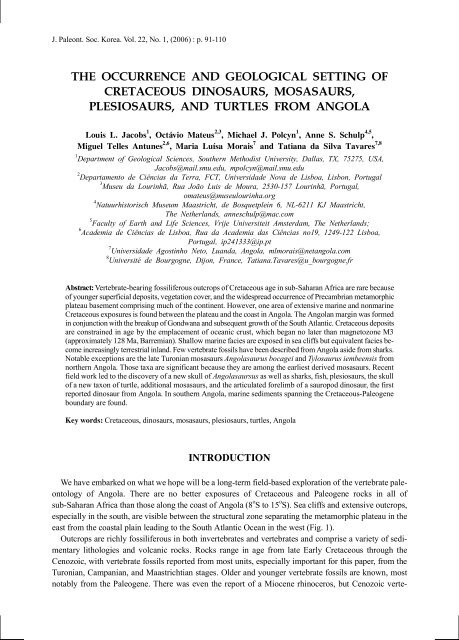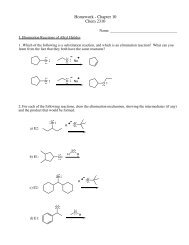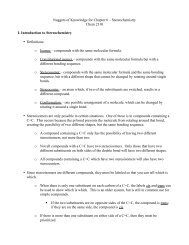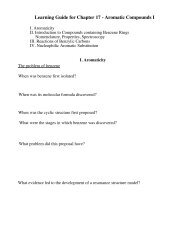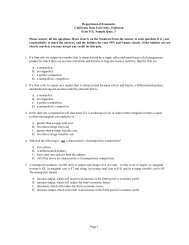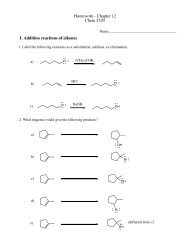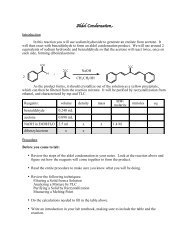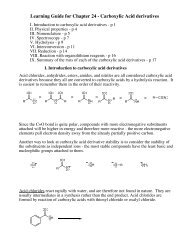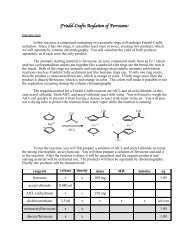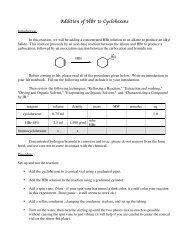the occurrence and geological setting of cretaceous dinosaurs
the occurrence and geological setting of cretaceous dinosaurs
the occurrence and geological setting of cretaceous dinosaurs
- No tags were found...
Create successful ePaper yourself
Turn your PDF publications into a flip-book with our unique Google optimized e-Paper software.
J. Paleont. Soc. Korea. Vol. 22, No. 1, (2006) : p. 91-110 á í 1 Department <strong>of</strong> Geological Sciences, Sou<strong>the</strong>rn Methodist University, Dallas, TX, 75275, USA,Jacobs@mail.smu.edu, mpolcyn@mail.smu.edu2 Departamento de Ciências da Terra, FCT, Universidade Nova de Lisboa, Lisbon, Portugal3 Museu da Lourinhã, Rua João Luis de Moura, 2530-157 Lourinhã, Portugal,omateus@museulourinha.org4 Natuurhistorisch Museum Maastricht, de Bosquetplein 6, NL-6211 KJ Maastricht,The Ne<strong>the</strong>rl<strong>and</strong>s, anneschulp@mac.com5 Faculty <strong>of</strong> Earth <strong>and</strong> Life Sciences, Vrije Universiteit Amsterdam, The Ne<strong>the</strong>rl<strong>and</strong>s;6 Academia de Ciências de Lisboa, Rua da Academia das Ciências no19, 1249-122 Lisboa,Portugal, ip241333@ip.pt7 Universidade Agostinho Neto, Lu<strong>and</strong>a, Angola, mlmorais@netangola.com8 Université de Bourgogne, Dijon, France, Tatiana.Tavares@u_bourgogne.frAbstract: Vertebrate-bearing fossiliferous outcrops <strong>of</strong> Cretaceous age in sub-Saharan Africa are rare because<strong>of</strong> younger superficial deposits, vegetation cover, <strong>and</strong> <strong>the</strong> widespread <strong>occurrence</strong> <strong>of</strong> Precambrian metamorphicplateau basement comprising much <strong>of</strong> <strong>the</strong> continent. However, one area <strong>of</strong> extensive marine <strong>and</strong> nonmarineCretaceous exposures is found between <strong>the</strong> plateau <strong>and</strong> <strong>the</strong> coast in Angola. The Angolan margin was formedin conjunction with <strong>the</strong> breakup <strong>of</strong> Gondwana <strong>and</strong> subsequent growth <strong>of</strong> <strong>the</strong> South Atlantic. Cretaceous depositsare constrained in age by <strong>the</strong> emplacement <strong>of</strong> oceanic crust, which began no later than magnetozone M3(approximately 128 Ma, Barremian). Shallow marine facies are exposed in sea cliffs but equivalent facies becomeincreasingly terrestrial inl<strong>and</strong>. Few vertebrate fossils have been described from Angola aside from sharks.Notable exceptions are <strong>the</strong> late Turonian mosasaurs Angolasaurus bocagei <strong>and</strong> Tylosaurus iembeensis fromnor<strong>the</strong>rn Angola. Those taxa are significant because <strong>the</strong>y are among <strong>the</strong> earliest derived mosasaurs. Recentfield work led to <strong>the</strong> discovery <strong>of</strong> a new skull <strong>of</strong> Angolasaursus as well as sharks, fish, plesiosaurs, <strong>the</strong> skull<strong>of</strong> a new taxon <strong>of</strong> turtle, additional mosasaurs, <strong>and</strong> <strong>the</strong> articulated forelimb <strong>of</strong> a sauropod dinosaur, <strong>the</strong> firstreported dinosaur from Angola. In sou<strong>the</strong>rn Angola, marine sediments spanning <strong>the</strong> Cretaceous-Paleogeneboundary are found.Cretaceous, <strong>dinosaurs</strong>, mosasaurs, plesiosaurs, turtles, AngolaWe have embarked on what we hope will be a long-term field-based exploration <strong>of</strong> <strong>the</strong> vertebrate paleontology<strong>of</strong> Angola. There are no better exposures <strong>of</strong> Cretaceous <strong>and</strong> Paleogene rocks in all <strong>of</strong>sub-Saharan Africa than those along <strong>the</strong> coast <strong>of</strong> Angola (8 o S to 15 o S). Sea cliffs <strong>and</strong> extensive outcrops,especially in <strong>the</strong> south, are visible between <strong>the</strong> structural zone separating <strong>the</strong> metamorphic plateau in <strong>the</strong>east from <strong>the</strong> coastal plain leading to <strong>the</strong> South Atlantic Ocean in <strong>the</strong> west (Fig. 1).Outcrops are richly fossiliferous in both invertebrates <strong>and</strong> vertebrates <strong>and</strong> comprise a variety <strong>of</strong> sedimentarylithologies <strong>and</strong> volcanic rocks. Rocks range in age from late Early Cretaceous through <strong>the</strong>Cenozoic, with vertebrate fossils reported from most units, especially important for this paper, from <strong>the</strong>Turonian, Campanian, <strong>and</strong> Maastrichtian stages. Older <strong>and</strong> younger vertebrate fossils are known, mostnotably from <strong>the</strong> Paleogene. There was even <strong>the</strong> report <strong>of</strong> a Miocene rhinoceros, but Cenozoic verte-
J. Paleont. Soc. Korea. Vol. 22, No. 1, 2006Fig. 1. General geographic representation <strong>of</strong> coastal Angola <strong>and</strong> its <strong>of</strong>fshore basins. Cretaceous <strong>and</strong> Paleogene rockscrop out along <strong>the</strong> coast <strong>and</strong> eastward to <strong>the</strong> hinge zone at <strong>the</strong> edge <strong>of</strong> <strong>the</strong> metamorphic plateau (shaded area). Areasmentioned in text are shown by symbols: Tadi (star north <strong>of</strong> Lu<strong>and</strong>a), Bentiaba (square south <strong>of</strong> Benguela), Fazendados Cavaleiros (triangle).brates are beyond <strong>the</strong> focus <strong>of</strong> <strong>the</strong> conference for which this report was prepared.The most recent comprehensive study <strong>of</strong> <strong>the</strong> stratigraphy <strong>and</strong> paleontology <strong>of</strong> <strong>the</strong> Angolan coast wasthat <strong>of</strong> Antunes (1964). More recently, Antunes <strong>and</strong> Cappetta (2002) published a systematic description<strong>of</strong> sharks collected primarily during <strong>the</strong> 1960’s by Antunes. (The surname Antunes has been inconsistently<strong>and</strong> incorrectly cited as Telles-Antunes or Telles Antunes; e.g., Bardet et al., 2005; Bell, 1997a,but not 1997b; Bell <strong>and</strong> Polcyn, 2005, but not Polcyn <strong>and</strong> Bell, 2005; Lingham-Soliar, 1994).Previous studies <strong>of</strong> outcrop between <strong>the</strong> coast <strong>and</strong> <strong>the</strong> interior plateau <strong>of</strong> Angola were completed priorto <strong>the</strong> general acceptance <strong>and</strong> full development <strong>of</strong> plate tectonic concepts, magnetostratigraphy, seismic<strong>and</strong> sequence stratigraphy, <strong>and</strong> high precision radiometric dating. Antunes (1964) predated <strong>the</strong> generaluse <strong>of</strong> phylogenetic systematic techniques, <strong>the</strong> recognition <strong>of</strong> bolide impact at <strong>the</strong> Cretaceous-Paleogenetransition, <strong>the</strong> application <strong>of</strong> stable isotopes to chemostratigraphic, paleoenvironmental, <strong>and</strong> paleoecologicalproblems, <strong>and</strong> <strong>the</strong> advent <strong>of</strong> such analytical <strong>and</strong> field tools as high resolution X-ray computed tomographyor GIS/GPS positioning. Nor have collections been improved by methodical acquisition <strong>of</strong>new material <strong>of</strong> known or additional taxa since <strong>the</strong> work <strong>of</strong> Antunes in <strong>the</strong> early 1960’s.In contrast, <strong>of</strong>fshore basins <strong>of</strong> Angola are recognized as being extremely important economically <strong>and</strong><strong>geological</strong>ly for <strong>the</strong>ir petroleum resources <strong>and</strong> as a <strong>geological</strong> record <strong>of</strong> <strong>the</strong> opening <strong>of</strong> <strong>the</strong> South AtlanticOcean during <strong>the</strong> breakup <strong>of</strong> Gondwana. Consequently, <strong>the</strong>re is an important <strong>and</strong> growing body <strong>of</strong> seismic<strong>and</strong> core data from <strong>the</strong> South Atlantic relevant to a more thorough underst<strong>and</strong>ing <strong>of</strong> <strong>the</strong> coastal deposits<strong>of</strong> onshore Angola. This is not only with respect to <strong>the</strong> initial formation <strong>of</strong> <strong>the</strong> South Atlantic, butas an environmental record <strong>of</strong> changing climatic, atmospheric, <strong>and</strong> oceanic conditions as <strong>the</strong> sea floorwidened during <strong>the</strong> Late Cretaceous <strong>and</strong> Cenozoic. Therefore, we begin this paper with a discussion <strong>of</strong><strong>of</strong>fshore geology as a background to underst<strong>and</strong>ing <strong>the</strong> <strong>geological</strong> history <strong>of</strong> vertebrate-bearing deposits<strong>of</strong> Angola, <strong>the</strong>n we discuss <strong>the</strong> localities visited in our 2005 field season, including preliminary observations<strong>and</strong> conclusions regarding fossils obtained at that time.
Jacobs et al. - Cretaceous vertebrates from Angola The geographic significance <strong>of</strong> Angola from a plate tectonic perspective is that it is <strong>the</strong> eastern border<strong>of</strong> <strong>the</strong> South Atlantic Ocean, formed in <strong>the</strong> breakup <strong>of</strong> Gondwana during <strong>the</strong> Mesozoic Era. Rifting washeralded in <strong>the</strong> area destined to become <strong>the</strong> sou<strong>the</strong>rnmost South Atlantic by regional uplift <strong>and</strong> volcanismduring <strong>the</strong> Jurassic Period, which continued progressively northward through <strong>the</strong> Early Cretaceous(Emery <strong>and</strong> Uchupi, 1984; Nurnberg <strong>and</strong> Muller, 1991). Flooding <strong>of</strong> <strong>the</strong> South Atlantic Ocean after initialvolcanism began south <strong>of</strong> Angola during Jurassic <strong>and</strong> Early Cretaceous time. Prior to <strong>the</strong> Barremian,subsidence <strong>of</strong> intracratonic rift basins far<strong>the</strong>r north, in <strong>the</strong> area that is now Angola, resulted in deposition<strong>of</strong> more than a kilometer <strong>of</strong> clastic detritus over pre-existing metamorphic basement rocks (Brice et al.,1982; Karner <strong>and</strong> Driscoll, 1999). Emplacement <strong>of</strong> oceanic crust along <strong>the</strong> Mid-Atlantic Ridge at <strong>the</strong>coast <strong>of</strong> Angola began no later than magnetozone M3, or approximately 128 Ma (Barremian; Ogg <strong>and</strong>Smith, 2004). Rifting appears to have been propagated from <strong>the</strong> Walvis Ridge hotspot (Fig. 1; St<strong>and</strong>lee etal., 1982).Moulin et al. (2005) utilized deep penetration multi-channel reflection <strong>and</strong> wide-angle seismic data todocument that Early Cretaceous strata are parallel to <strong>the</strong> base <strong>of</strong> Aptian evaporites, <strong>the</strong>reby indicatingthat pre-Aptian beds were little affected by tectonic deformation during initial rifting. They conclude thatenvironments <strong>of</strong> deposition were shallow during that phase <strong>of</strong> rifting <strong>and</strong> that horizontal motion was less<strong>of</strong> a factor than vertical motion during basin formation (see also Reston et al., 1996). FollowingCretaceous rifting, Africa was uplifted in <strong>the</strong> Cenozoic relative to o<strong>the</strong>r continents (Bond, 1978;Sahagian, 1988; Lunde et al., 1992; Nyblade <strong>and</strong> Robinson, 1994). However, nei<strong>the</strong>r <strong>the</strong> rates nor <strong>the</strong>timing <strong>of</strong> ei<strong>the</strong>r Cretaceous or Cenozoic regional or continental vertical motions are precisely known, althoughit does not seem unlikely that <strong>the</strong> tectonic style <strong>of</strong> <strong>the</strong> formation <strong>of</strong> <strong>the</strong> South Atlantic played arole in <strong>the</strong> initial expression <strong>of</strong> <strong>the</strong> continental metamorphic plateau east <strong>of</strong> <strong>the</strong> current Angolan coastalplain.From north to south, <strong>the</strong> <strong>of</strong>fshore basins <strong>of</strong> Angola that extend l<strong>and</strong>ward are referred to as <strong>the</strong> LowerCongo, Kwanza, Benguela, <strong>and</strong> Namibe (Fig. 1). Conjugate basins have been identified on <strong>the</strong> Brazilianmargin <strong>of</strong> <strong>the</strong> South Atlantic (Cainelli <strong>and</strong> Mohriak, 1999), reflecting <strong>the</strong>ir common origin. Separating<strong>the</strong> <strong>of</strong>fshore basins along <strong>the</strong> Angola passive margin are <strong>the</strong> Ambriz Arch between <strong>the</strong> Lower Congo <strong>and</strong>Kwanza basins (7° to 8°S; St<strong>and</strong>lee et al., 1992), an east-sou<strong>the</strong>ast trending chain <strong>of</strong> volcanic seamountsbetween <strong>the</strong> Kwanza <strong>and</strong> Benguela basins (11°S, Schollnberger, 2001), <strong>and</strong> <strong>the</strong> Walvis Ridge, which divides<strong>the</strong> Benguela from <strong>the</strong> Namibe Basin (approximately 18°S near <strong>the</strong> continent; Lehner <strong>and</strong> deRuiter, 1977).(“Kwanza” is <strong>the</strong> English spelling <strong>and</strong> is used consistently, but not exclusively, in that form in Englishscientific literature. The spelling in Romance languages is “Cuanza,” <strong>and</strong> it is used in that form inPortuguese scientific literature. We use <strong>the</strong> term Namibe Basin to conform with <strong>the</strong> town <strong>and</strong> <strong>the</strong> provinceas <strong>the</strong>y are now called, as opposed to <strong>the</strong> older synonym, Moçâmedes Basin.)Cretaceous deposition from Barremian onward is generally comparable among <strong>the</strong> Angolan <strong>of</strong>fshorebasins in terms <strong>of</strong> lithology <strong>and</strong> stratigraphic thickness. Above <strong>the</strong> initial synrift sequence are s<strong>and</strong>stonesup to 200 meters thick, which represent <strong>the</strong> initiation <strong>of</strong> marine deposition along <strong>the</strong> Angola margin (Ala<strong>and</strong> Selley, 1997; Marton et al., 2000). Lower Aptian rocks are dominantly evaporites, which may signifyrestriction <strong>of</strong> <strong>the</strong> Angolan basins from open oceanic circulation by vertical motion along <strong>the</strong> WalvisRidge <strong>and</strong> o<strong>the</strong>r topographic features <strong>of</strong> <strong>the</strong> South Atlantic seafloor. Above <strong>the</strong> evaporites are thick carbonate<strong>and</strong> clastic units (Brognon <strong>and</strong> Verrier, 1966a, b; Gerrard <strong>and</strong> Smith, 1982). Post-Aptian salt tectonismis extensive <strong>and</strong> exacerbated by regional westward tilt (Schollnberger, 2001; Hudec <strong>and</strong> Jackson,
J. Paleont. Soc. Korea. Vol. 22, No. 1, 20062004).Schollnberger (2001) studied two-dimensional seismic pr<strong>of</strong>iles <strong>of</strong> <strong>the</strong> three nor<strong>the</strong>rn Angola <strong>of</strong>fshorebasins <strong>and</strong> correlated four unconformity-bounded, second-order (10-100 Ma) sequences, which span <strong>the</strong>time from <strong>the</strong> end <strong>of</strong> <strong>the</strong> Aptian through <strong>the</strong> Cenozoic. In addition, Schollnberger (2001) recognizedwidely varying numbers <strong>of</strong> third-order (1-10 Ma) <strong>and</strong> fourth-order (0.2-0.5 Ma) unconformity-boundedsequences among <strong>the</strong> basins. The mechanisms that can create marine unconformities are sea-level fluctuations,changing circulation patterns, <strong>and</strong> tectonic activity, including salt tectonism <strong>and</strong> source-area perturbationsthat may have affected <strong>the</strong> distribution <strong>of</strong> depocenters or sediment provenance. Variation in<strong>the</strong> number <strong>of</strong> unconformity-bounded, third- <strong>and</strong> fourth-order sequences among <strong>the</strong> Angolan basins suggestsbasin-specific attributes, <strong>the</strong> causes <strong>of</strong> which remain undefined.Biostratigraphic <strong>and</strong> lithostratigraphic control for <strong>the</strong> seismic study <strong>of</strong> Schollnberger (2001) was providedby a core from DSDP site 364 in <strong>the</strong> Benguela Basin (Bolli <strong>and</strong> Ryan, 1978). More recent drillingby <strong>the</strong> Ocean Drilling Project on ODP leg 208 in <strong>the</strong> South Atlantic on <strong>the</strong> nor<strong>the</strong>astern flank <strong>of</strong> <strong>the</strong>Walvis Ridge specifically focuses on data relevant to underst<strong>and</strong>ing <strong>the</strong> Cretaceous-Paleogene transition<strong>and</strong> Paleogene climatic events (Shipboard Scientific Party, 2003). No relevant data are currently availablefrom onshore Africa for rigorous comparison with those data derived from <strong>the</strong> Walvis Ridge by <strong>the</strong>ODP, but <strong>the</strong> most likely prospect for deriving relevant data from <strong>the</strong> mainl<strong>and</strong> is from outcrops inAngola where Cretaceous <strong>and</strong> Paleogene deposits are exposed. One needs only examine <strong>the</strong> maps in Antunes (1964) or Antunes <strong>and</strong> Cappetta (2002) to see <strong>the</strong> richdistribution <strong>of</strong> fossil localities along <strong>the</strong> coast <strong>of</strong> Angola, from Cabinda, <strong>the</strong> nor<strong>the</strong>rnmost <strong>and</strong> most vegetatedprovince, to Namibe Province in <strong>the</strong> south, where vegetation is sparse <strong>and</strong> exposures are superb.Although <strong>the</strong> fossils described by Antunes are <strong>of</strong> a variety <strong>of</strong> Cretaceous <strong>and</strong> Cenozoic ages, <strong>the</strong>y are almostexclusively marine. The most abundant fossils pertain to sharks <strong>and</strong> bony fish, but a suite <strong>of</strong> marineamniotes, most <strong>of</strong>ten fragmentary but occasionally quite complete, were noted.The most significant fossils studied by Antunes were two <strong>of</strong> <strong>the</strong> world’s oldest derived mosasaurs,Angolasaurus bocagei <strong>and</strong> Tylosaurus iembeensis. He also reported plesiosaurs, turtle, at least two additionalmosasaur taxa, <strong>and</strong> a variety <strong>of</strong> fish <strong>and</strong> sharks <strong>of</strong> Late Cretaceous age (o<strong>the</strong>r fossils, includingfish, turtle, crocodile, snake, cetaceans, <strong>and</strong> rhinoceros, were reported from Cenozoic strata). In our fieldseason <strong>of</strong> 2005 we visited three localities (Fig. 1) near to or identical with those reported by Antunes(1964): Iembe, <strong>the</strong> type locality <strong>of</strong> Angolasaurus bocagei <strong>and</strong> Tylosaurus iembeensis in <strong>the</strong> KwanzaBasin, nor<strong>the</strong>rn Angola; Bentiaba <strong>and</strong> Fazenda dos Cavaleiros in <strong>the</strong> Namibe Basin, sou<strong>the</strong>rn Angola.Antunes obtained time control from ammonites <strong>and</strong> o<strong>the</strong>r invertebrates, <strong>and</strong> he established a chronologybased on sharks <strong>and</strong> bony fishes. The ichthy<strong>of</strong>auna identified from <strong>the</strong> localities we visited are listed inTable 1, compiled from Antunes <strong>and</strong> Cappetta (2002), which concluded that Iembe is late Turonian inage (but see subsequent discussion) <strong>and</strong> <strong>the</strong> o<strong>the</strong>r two localities are younger.Kwanza Basin-The age <strong>of</strong> Iembe is particularly important because it produces <strong>the</strong> oldest mosasaursknown from <strong>the</strong> South Atlantic <strong>and</strong> it has produced a dinosaur, as well as turtle <strong>and</strong> plesiosaur. The localitylies near Tadi in <strong>the</strong> Kwanza Basin, north <strong>of</strong> Lu<strong>and</strong>a in Bengo Province (817 o S, 1321 o E; Fig. 1). It isstratigraphically within <strong>the</strong> Tadi Beds <strong>of</strong> <strong>the</strong> Itombe Formation (Fig. 2, 3), which is shown in quotationmarks by Antunes <strong>and</strong> Cappetta (2002, p. 95, but not p. 90) because beds <strong>of</strong> different ages were lumpedtoge<strong>the</strong>r into <strong>the</strong> same formation. The time discrepancy <strong>of</strong> <strong>the</strong> included strata is so great (Turonian versusCampanian; Antunes <strong>and</strong> Cappetta, 2002) <strong>and</strong> <strong>the</strong> facies relationships so ill defined that considering <strong>the</strong>Tadi Beds as part <strong>of</strong> <strong>the</strong> Itombe Formation is unwarranted. The upper portion <strong>of</strong> <strong>the</strong> Itombe Formationcorresponds to <strong>the</strong> Middle Campanian Globotruncata ventricosa Zone, <strong>and</strong> <strong>the</strong> lower portion, <strong>the</strong> Tadi
J. Paleont. Soc. Korea. Vol. 22, No. 1, 2006Fig. 2. Correlation <strong>of</strong> Angolan Cretaceous fossil localities visited in 2005.Fig. 3. Iembe, near Tadi, at or near <strong>the</strong> type locality <strong>of</strong> Angolasaurus bocagei <strong>and</strong> Tylosaurus iembeensis. The new skull<strong>of</strong> Angolasaurus was found (by O.M.) approximately at <strong>the</strong> arrow.
Jacobs et al. - Cretaceous vertebrates from Angola1985) has direct bearing on <strong>the</strong> age <strong>of</strong> <strong>the</strong> Tadi Beds or <strong>the</strong> Iembe locality. No vertebrates are known from<strong>the</strong> Pambala Beds (Antunes, 1964), but overlying <strong>the</strong> Pambala Beds in <strong>the</strong> Kwanza Basin is <strong>the</strong>Maastrichtian Teba Formation with <strong>the</strong> fossiliferous Barra do D<strong>and</strong>e Beds, which produce shark, bonyfish, plesiosaur, <strong>and</strong> mosasaur teeth.Brognon et al. (1960; cited in Antunes, 1964) reported echinoderms <strong>and</strong> <strong>the</strong> ammonites Hemitissotia,Romaniceras, <strong>and</strong> Pachydiscus from <strong>the</strong> vicinity <strong>of</strong> <strong>the</strong> Iembe site. In Europe, Hemitissotia is most characteristic<strong>of</strong> <strong>the</strong> Upper Coniacian (Gräfe <strong>and</strong> Wiedmann, 1998). Romaniceras deverianum is a potentialprimary marker for <strong>the</strong> Upper Turonian (Ogg et al., 2004), but R. hispanicum (which we take to be a species<strong>of</strong> Romaniceras) is shown as Coniacian in Gräfe <strong>and</strong> Wiedmann (1998:fig. 3). Pachydiscus, aCampanian <strong>and</strong> Maastrichtian genus, must be misidentified or <strong>the</strong> sample is mixed; we will not considerit fur<strong>the</strong>r as it appears to be <strong>of</strong> no relevant chronological value in this instance. Based strictly on <strong>the</strong> ammonitesHemitissotia <strong>and</strong> Romaniceras <strong>and</strong> our underst<strong>and</strong>ing <strong>of</strong> <strong>the</strong>ir distributions, it would appear that<strong>the</strong> age <strong>of</strong> Iembe might conceivably fall within a maximum range extending from Late Turonian throughConiacian, or about 89±3 Ma.We accept for <strong>the</strong> moment <strong>the</strong> interpretation <strong>of</strong> Antunes (1964) <strong>and</strong> Antunes <strong>and</strong> Capetta (2002) that,based on sharks primarily, <strong>the</strong> locality <strong>of</strong> Iembe is Late Turonian in age (which is consistent with <strong>the</strong> numericalestimate presented here). However, we note that Antunes <strong>and</strong> Cappetta (2002) provide faunallists for Cenomanian, Late Turonian, <strong>and</strong> Santonian-to-Lower-Campanian ichthy<strong>of</strong>aunas, but <strong>the</strong>y do notprovide a locality or a faunal list for Early Turonian or Coniacian ichthy<strong>of</strong>aunas, which are currently unknownin Angola, rendering it difficult to defend <strong>the</strong> precision <strong>of</strong> a Late Turonian age based on strictcomparison with o<strong>the</strong>r Angolan sites. On <strong>the</strong> o<strong>the</strong>r h<strong>and</strong>, a Turonian age is supported by <strong>the</strong> correlation<strong>of</strong> <strong>the</strong> ichthy<strong>of</strong>auna to that <strong>of</strong> Bula Zambi in <strong>the</strong> Republic <strong>of</strong> Congo, which has long been accepted asTuronian in age (e.g., by Haughton, 1963).Namibe Basin-At Bentiaba (1416 o S, 1221 o E, Fig. 1), we discovered rich deposits <strong>of</strong> relatively completemosasaurs <strong>and</strong> plesiosaurs. Exposures are extensive (Fig. 4). Low in <strong>the</strong> section at Bentiaba an alkalibasalt flow is interbedded with near shore marine strata (Fig. 5; Borges, 1946; Carvalho; 1961).Cooper (1972) noted <strong>the</strong> lack <strong>of</strong> pillow structures in <strong>the</strong> basalt. He (Cooper, 1978) also documented <strong>the</strong><strong>occurrence</strong> <strong>of</strong> Cenomanian <strong>and</strong> Turonian ammonites below <strong>the</strong> basalt <strong>and</strong> Santonian <strong>and</strong> Campanian ammonitesabove <strong>the</strong> basalt. He <strong>the</strong>refore, based on stratigraphy <strong>and</strong> invertebrate biochronology, consideredthat <strong>the</strong> basalts were extruded during an emergent interval during <strong>the</strong> Coniacian, probably LateConiacian (i.e., 86 Ma, fide Gradstein et al., 2004). He did not find a rich Upper Campanian fauna similarto that <strong>of</strong> Egito or a Maastrichtian fauna like that found in <strong>the</strong> Kwanza Basin. Cooper recognized, as wedid, <strong>the</strong> beds rich in sharks <strong>and</strong> o<strong>the</strong>r vertebrates, including what he (<strong>and</strong> Carvalho, 1961:fig. 128) calledMosasaurus beaugei (although we have not identified that taxon from Bentiaba). Cooper (1972) concludedthat <strong>the</strong>re was not enough section present above <strong>the</strong> basalt to have a complete record fromSantonian through Maastrichtian, <strong>and</strong> he concluded that <strong>the</strong> section ended in <strong>the</strong> Campanian with <strong>the</strong>Late Campanian <strong>and</strong> Maastrichtian not present. Soares (1965) reported Campanian (?) bivalves from <strong>the</strong>area.On <strong>the</strong> o<strong>the</strong>r h<strong>and</strong>, Antunes (1964, 1966) had several localities overlying <strong>the</strong> basalt in <strong>the</strong> vicinity <strong>of</strong><strong>the</strong> town <strong>of</strong> Bentiaba (which he referred to as São Nicolau), in <strong>the</strong> same area that Cooper worked later.Antunes (1964, 1966) <strong>and</strong> Antunes <strong>and</strong> Cappetta (2002) determined <strong>the</strong> age <strong>of</strong> <strong>the</strong> beds as Campanian<strong>and</strong> Maastrichtian based on <strong>the</strong> invertebrates <strong>and</strong> <strong>the</strong> ichthy<strong>of</strong>auna (Table 1), including Squalicorax pristodontus,which <strong>the</strong>y recognize as a Maastrichtian species in Angola, consistent with its <strong>occurrence</strong> elsewhere,<strong>and</strong> o<strong>the</strong>r shark taxa that were also mentioned by Cooper (1972).Near <strong>the</strong> town <strong>of</strong> Namibe, Antunes recognized <strong>the</strong> Cretaceous-Paleogene transition at Fazenda dosCavaleiros, a site we visited in 2005 (158 o S, 1213 o E; Antunes, 1964:plate 9:figs. 21, 22; our Fig. 6).
J. Paleont. Soc. Korea. Vol. 22, No. 1, 2006Fig. 4. Late Cretaceous (Campanian-Maastrichtian fide Antunes <strong>and</strong> Cappetta, 2002) beds <strong>of</strong> Bentiaba (photo by OM).Fig. 5. Volcanic flow intercalated with late Cretaceous shallow marine sediments, north <strong>of</strong> Bentiaba (photo by OM).Within <strong>the</strong> section, high-energy terrigenous conglomerates are interbedded with nearshore marine s<strong>and</strong>s.The conglomerates can be traced laterally for extended distances, some at least, into more terrestrialchannel <strong>and</strong> overbank facies associated with volcanics <strong>and</strong> evaporites (Fig. 7). The evaporites presumablywere emplaced via post-Aptian salt tectonics as is also seen in <strong>of</strong>fshore seismic sections. Nei<strong>the</strong>r <strong>the</strong>volcanics at Bentiaba or east <strong>of</strong> Fazenda dos Cavaleiros have been radiometrically dated.Facies Relations-Coupled with <strong>the</strong> marine record, from <strong>the</strong> point <strong>of</strong> view <strong>of</strong> exploration, <strong>the</strong>re is entic-
Jacobs et al. - Cretaceous vertebrates from AngolaFig. 6. Fazenda dos Cavaleiros. Cretaceous-Paleogene transition is about midway up <strong>the</strong> outcrop face (photo by OM).Fig. 7. Cretaceous terrestrial sediments with evaporites juxtaposed along igneous rocks in western Namibe Province(photo by LLJ).ing evidence along much <strong>of</strong> <strong>the</strong> passive margin <strong>of</strong> coastal West Africa that marine facies grade into moreterrestrial facies <strong>and</strong> that both are fossiliferous. From <strong>the</strong> Eocene <strong>of</strong> Togo, for instance, Gingerich et al.(1992) reported sharks, whales, <strong>and</strong> sirenians, as well as possible l<strong>and</strong> mammals. In Cabinda, marine vertebrateshave long been known from <strong>the</strong> Paleogene <strong>of</strong> L<strong>and</strong>ana (e.g., most recently Schwarz, 2003) <strong>and</strong>terrestrial fossils have been recognized from Malembo, near L<strong>and</strong>ana. Antunes (1964:plate 12:fig. 28)indicates a rhinoceros from Miocene strata near <strong>the</strong> coast <strong>of</strong> Angola. A similar marine-nonmarine facies
J. Paleont. Soc. Korea. Vol. 22, No. 1, 2006relationship also pertains to <strong>the</strong> Cretaceous in all three <strong>of</strong> <strong>the</strong> areas we visited. The section at Fazenda dosCavaleirosin <strong>the</strong> Namibe Basin comprises near shore marine s<strong>and</strong>s with interbedded terrigenous conglomeratesthat can be traced into terrestrial facies. Marine to terrestrial facies relationships in <strong>the</strong> sou<strong>the</strong>rnKwanza Basin were recognized by Brognon <strong>and</strong> Verrier (1965a, b). The section at Iembe in <strong>the</strong> nor<strong>the</strong>rnKwanza Basin shows clear indications <strong>of</strong> terrestrial influx, <strong>and</strong> including ferruginous alternations,<strong>and</strong> as mentioned, it has produced a dinosaur. In Angola, <strong>and</strong> along great expanses <strong>of</strong> coastal areas <strong>of</strong>sub-Saharan Africa on both sides <strong>of</strong> <strong>the</strong> continent, <strong>the</strong> possibilities <strong>of</strong> marine to nonmarine facies transitionsare encapsulated in relatively narrow <strong>and</strong> <strong>of</strong>ten poorly exposed rocks <strong>of</strong> <strong>the</strong> coastal plain between<strong>the</strong> shoreline <strong>and</strong> <strong>the</strong> crystalline plateau, which comprises much <strong>of</strong> <strong>the</strong> continental interior. Depositionalong that swath reflects regional basin evolution, continental source areas, <strong>and</strong> sedimentation duringtransgressive-regressive cycles, <strong>and</strong> presents opportunities for investigations <strong>of</strong> <strong>the</strong> <strong>geological</strong> <strong>and</strong> paleontologicalhistory <strong>of</strong> Africa. The best known amniote fossil taxa from Angola are those described by Antunes (1964), that is, <strong>the</strong>mosasaurs Angolasaurus bocagei <strong>and</strong> Tylosaurus iembeensis. The holotype <strong>of</strong> <strong>the</strong> latter taxon may havebeen lost in a fire. Although no systematic collections have been made since Antunes, in our short time inAngola during 2005, a variety <strong>of</strong> vertebrate fossils in various degrees <strong>of</strong> completeness were found.Among those, one <strong>of</strong> us (Octávio Mateus) discovered several important specimens that deserve fur<strong>the</strong>rcomment.Chelonia-An apparently new taxon <strong>of</strong> turtle is represented by a nearly complete but fractured skull(Fig. 8) from near <strong>the</strong> Iembe Angolasaurus site. The specimen has not been fully prepared, but it appearsto have a suite <strong>of</strong> derived <strong>and</strong> primitive characters, among o<strong>the</strong>rs, divided nares, an extensive secondarypalate, incisura columellae auris enclosing stapes, elongate squamosal processes, narrow interorbitalFig. 8. Turtle skull from Iembe coast (4.5 km north <strong>of</strong> Tadi; photo by OM).
Jacobs et al. - Cretaceous vertebrates from Angolawidth, <strong>and</strong> dorsally directed orbits. A closed incisura columella <strong>and</strong> extensive secondary palate haveevolved multiple times, <strong>the</strong> secondary palate to various degrees. Although found in marine sediments,<strong>the</strong> Iembe turtle is excluded from membership in <strong>the</strong> chelonioid sea turtles. It has a more extensive secondarypalate than modern sea turtles but similar to some o<strong>the</strong>r marine cryptodires, such as <strong>the</strong> AptianS<strong>and</strong>ownia (Meylan et al., 2000).Plesiosauria-Antunes (1964) reported a relatively complete plesiosaur specimen from a locality nearIembe, but it has never been studied. Several o<strong>the</strong>r localities mentioned in his monograph include fragmentaryplesiosaurs in <strong>the</strong> faunal list. We found plesiosaur remains in each <strong>of</strong> <strong>the</strong> three areas we visited(Fig. 9). Bentiaba appears to be particularly rich in plesiosaur remains.Angolasaurus-Mosasaurs are well represented at least in <strong>the</strong> Late Turonian <strong>and</strong> Campanian-Maastrichtian portions <strong>of</strong> <strong>the</strong> Angola Cretaceous section. In 1960, M.G. Mascarenhas Neto, <strong>the</strong>n a geologistin Serviços de Geologia e Minas, <strong>and</strong> Miguel Telles Antunes obtained a skull with some postcraniafrom Iembe. Antunes (1961) initially identified <strong>the</strong> material as Platecarpus sp. but later (Antunes, 1964)studied it more fully <strong>and</strong> erected <strong>the</strong> name Angolasaurus bocagei for it. Antunes placed Angolasaurus within<strong>the</strong> Mosasaurinae. Its age is considered to be Late Turonian as explained previously, although <strong>the</strong> taxonitself appears ra<strong>the</strong>r derived for such an early age relative to <strong>the</strong> history <strong>of</strong> mosasaurs. The specimenwas later studied by Lingham-Soliar (1994), who recognized it as a member <strong>of</strong> <strong>the</strong> SubfamilyPlioplatecarpinae. As a result <strong>of</strong> his study, he synonymized <strong>the</strong> genus Angolasaurus with Platecarpus;however, he retained <strong>the</strong> species <strong>and</strong> placed it (as P. bocagei) in his Tribe Platecarpini, which is shown inhis figure 8 to be a paraphyletic group.More recently, Polcyn <strong>and</strong> Bell (2005; see also Bell <strong>and</strong> Polcyn, 2005) included Angolasaurus in <strong>the</strong>irphylogenetic analysis. The matrix <strong>the</strong>y employed was largely based on Bell (1997b), constructed forAdriatic <strong>and</strong> North American mosasaurs, but exp<strong>and</strong>ed somewhat. There is not total concordance <strong>of</strong> <strong>the</strong>taxa or characters utilized in <strong>the</strong> analyses <strong>of</strong> Polcyn <strong>and</strong> Bell as compared to that <strong>of</strong> Lingham-Soliar, <strong>and</strong>consequently, <strong>the</strong> hypo<strong>the</strong>ses presented by those different authors are not strictly comparable. Specifically,according to Lingham-Soliar (1994), Prognathodon solvayi <strong>and</strong> Halisaurus ortliebi nest within <strong>the</strong>Fig. 9. In situ plesiosaur remains at Bentiaba.
J. Paleont. Soc. Korea. Vol. 22, No. 1, 2006Plioplatecarpinae as more dervived than Angolasaurus bocagei. According to Polcyn <strong>and</strong> Bell (2005)both fall outside <strong>the</strong> Plioplatecarpinae, with Prognathodon (at least P. rapax) grouped as a globidensine<strong>and</strong> Halisaurus represented in <strong>the</strong> sister group to Russellosaurina plus Plioplatecarpinae plus Tylosaurinae.In contrast to Lingham-Soliar (1994), in <strong>the</strong> cladogram <strong>of</strong> Bell <strong>and</strong> Polcyn (2005) <strong>and</strong> Polcyn <strong>and</strong> Bell(2005), Angolasaurus bocagei falls on its own branch, suggesting that it is in fact a valid taxon.Never<strong>the</strong>less, <strong>the</strong>ir (Bell <strong>and</strong> Polcyn, 2005; Polcyn <strong>and</strong> Bell, 2005) results show Angolasaurus nestedwith Ectenosaurus, Platecarpus, <strong>and</strong> Plioplatecarpus, forming a monophyletic group (Plioplatecarpinae)that would include both <strong>the</strong> Platecarpini <strong>and</strong> Plioplatecarpini <strong>of</strong> Lingham-Soliar (1994). However, <strong>the</strong>ircladogram places Angolasaurus between Platecarpus planifrons <strong>and</strong> Platecarpus tympanicus, highlightingan inconsistency: Ei<strong>the</strong>r <strong>the</strong> genus Platecarpus is paraphyletic, or <strong>the</strong> resolution surroundingAngolasaurus is incorrect.Our field work in May, 2005, resulted in <strong>the</strong> collection <strong>of</strong> a second skull <strong>of</strong> Angolasaurus (Fig. 10).For now, our tentative conclusions are that <strong>the</strong> cladogram <strong>of</strong> Polcyn <strong>and</strong> Bell (2005) presents a viable hypo<strong>the</strong>sis,that Angolasaurus bocagei is a valid taxon, <strong>and</strong> that because Platecarpus tympanicus is <strong>the</strong> typespecies <strong>of</strong> <strong>the</strong> genus, P. planifrons should be placed in its own genus, separate from ei<strong>the</strong>r Platecarpus orAngolasaurus.Globidensine mosasaurs-Globidensine mosasaurs are characterized (in part) by <strong>the</strong> robust nature, peculiarmorphology, <strong>and</strong> reduced number <strong>of</strong> <strong>the</strong>ir teeth, most obviously developed in Globidens, teeth <strong>of</strong>which were reported from Bentiaba <strong>and</strong> from Chibuete near <strong>the</strong> border with <strong>the</strong> Republic <strong>of</strong> Congo byAntunes (1964). However, excellent skull material tentatively referred to <strong>the</strong> globidensine Prognathodon(Fig. 11) was recovered from Bentiaba in 2005, fur<strong>the</strong>r documenting ecological differentiation amongmosasaurs during <strong>the</strong> Campanian <strong>and</strong> Maastrichtian over a broad geographic area in both <strong>the</strong> nor<strong>the</strong>rn<strong>and</strong> sou<strong>the</strong>rn hemispheres.Sauropoda-Arguably, <strong>the</strong> most important fossil found in <strong>the</strong> 2005 expedition is <strong>the</strong> articulated forelimb<strong>of</strong> a sauropod dinosaur (Fig. 12), because it is <strong>the</strong> first Cretaceous terrestrial vertebrate discovered inAngola <strong>and</strong> <strong>the</strong>refore opens <strong>the</strong> door to a new fossil field for African Cretaceous terrestrial biota.Fig. 10. New skull <strong>of</strong> Angolasaurus at Tadi (photo by OM).
Jacobs et al. - Cretaceous vertebrates from AngolaFig. 11. Prognathodon sp. skull at Bentiaba (Photos by OM <strong>and</strong> Carlos Natário).Fig. 12. Sauropod ulna <strong>and</strong> manus elements at Iembe near type locality <strong>of</strong> Angolasaurus (photo by OM).Although <strong>the</strong> specimen was found in near shore marine sediments, <strong>the</strong> association <strong>of</strong> <strong>the</strong> bones <strong>and</strong> <strong>the</strong>terrigenous input into <strong>the</strong> strata indicates proximity to <strong>the</strong> paleoshoreline. Moreover, this specimen,found in sediments at or near <strong>the</strong> end <strong>of</strong> <strong>the</strong> Turonian, is probably <strong>the</strong> most precisely dated Cretaceous dinosaurin sub-Saharan Africa. The morphology <strong>of</strong> <strong>the</strong> ulna suggests that <strong>the</strong> forelimb does not belong to atitanosaurian (Mateus et al., submitted).In Angola, Cretaceous deposits are <strong>of</strong> mostly shallow marine facies along <strong>the</strong> coast but may become
J. Paleont. Soc. Korea. Vol. 22, No. 1, 2006increasingly terrestrial inl<strong>and</strong> until <strong>the</strong> metamorphic plateau is reached. Terrigenous detritus <strong>and</strong> torrentialbeds in marine facies can be traced l<strong>and</strong>ward into terrestrial facies with <strong>the</strong> possibility <strong>of</strong> approachinga stratigraphically controlled sequence <strong>of</strong> both terrestrial <strong>and</strong> marine vertebrates spanning <strong>the</strong> Cretaceous-Paleogene transition. Fur<strong>the</strong>r, Angola <strong>of</strong>fers <strong>the</strong> best opportunity for correlation <strong>of</strong> <strong>the</strong> onshore Africanrock record to <strong>the</strong> much better-known <strong>and</strong> calibrated record <strong>of</strong> <strong>the</strong> South Atlantic Ocean. Recent drillingon ODP leg 208 in <strong>the</strong> South Atlantic on <strong>the</strong> nor<strong>the</strong>astern flank <strong>of</strong> <strong>the</strong> Walvis Ridge specifically focuseson data relevant to underst<strong>and</strong>ing <strong>the</strong> Cretaceous-Paleogene transition, <strong>the</strong> Early Eocene ClimaticOptimum, <strong>the</strong> Paleocene-Eocene Thermal Maximum, <strong>and</strong> <strong>the</strong> Early Oligocene Glacial Maximum(Shipboard Scientific Party, 2003). No relevant data are currently available from onshore Africa for rigorouscomparison with those derived from <strong>the</strong> Walvis Ridge by <strong>the</strong> ODP, but <strong>the</strong> most likely prospect forderiving relevant data from <strong>the</strong> mainl<strong>and</strong> is from outcrops in Angola where Cretaceous <strong>and</strong> Paleogenedeposits are exposed.From a biogeographic <strong>and</strong> tectonic perspective, <strong>the</strong> location <strong>of</strong> Angola along <strong>the</strong> eastern margin <strong>of</strong> <strong>the</strong>South Atlantic has particular significance. Hay et al. (1999) suggest that <strong>the</strong> early South Atlantic wassimilar in its parallel-sided geometry to <strong>the</strong> Red Sea, only three times as long. It lay in latitudes in whichevaporation exceeded precipitation, <strong>and</strong> at <strong>the</strong> time, did not receive influx from major rivers, such as itdoes today with respect to <strong>the</strong> Congo <strong>and</strong> <strong>the</strong> Amazon. The result was elevated salinity as is evident fromextensive evaporite deposits. The connection <strong>of</strong> <strong>the</strong> North <strong>and</strong> South Atlantic oceans, at least with respectto surface circulation, occurred during <strong>the</strong> Albian (Reyment <strong>and</strong> Dingle, 1987; Maisey, 2000; Albiancomprises <strong>the</strong> interval 112-99.6 Ma following Gradstein et al., 2004). Cooper (1978) noted that <strong>the</strong> latestAlbian was a time <strong>of</strong> lowered global sea level but <strong>the</strong> Angolan ammonite fauna <strong>of</strong> that time includes anumber <strong>of</strong> European forms, confirming connection <strong>of</strong> <strong>the</strong> North <strong>and</strong> South Atlantic during Albian lowsea st<strong>and</strong>. However, while it appears true that short-term sea-level change may have caused fluctuations,<strong>the</strong> overall trend from Early Albian through <strong>the</strong> Cenomanian was a rising sea level (Haq et al., 1988).Ocean modeling <strong>of</strong> reduced-gravity to determine upwelling has simulated <strong>the</strong> Cenomanian AtlanticOcean connection to have been 300 m deep (H<strong>and</strong>oh et al., 1999). The connection between <strong>the</strong> North<strong>and</strong> South Atlantics grew stronger, in general, as sea level rose throughout <strong>the</strong> middle part <strong>of</strong> <strong>the</strong>Cretaceous. This interval was one <strong>of</strong> high sea-surface temperatures, <strong>and</strong> Late Cenomanian to EarlyTuronian ammonite zones are widely distributed, including in <strong>the</strong> Western Interior Seaway <strong>of</strong> NorthAmerica, in inundated areas <strong>of</strong> northwest Africa, <strong>and</strong> in Angola (Cooper, 1978; Jacobs et al., 2005a,b).Numerical simulations, as well as <strong>the</strong> marine record, suggest that <strong>the</strong> initiation <strong>of</strong> completion <strong>of</strong> <strong>the</strong>Atlantic Ocean drove climatic <strong>and</strong> oceanographic changes surrounding <strong>the</strong> Cenomanian-Turonian boundary(Poulsen et al., 2001).Biogeographic precision concerning when, where, <strong>and</strong> how many times <strong>the</strong> three major marine amniotegroups in Angola during <strong>the</strong> Cretaceous (turtles, plesiosaurs, <strong>and</strong> mosasaurs) dispersed into <strong>the</strong>South Atlantic must await phylogenetic analysis <strong>of</strong> Angolan representatives in conjunction with tectonichistory, precise chronology, <strong>and</strong> global distribution <strong>of</strong> relevant taxa. Turtles <strong>and</strong> plesiosaurs have a longeraquatic history than mosasaurs <strong>and</strong> could have entered <strong>the</strong> opening ocean from <strong>the</strong> south, if <strong>the</strong>y were nothampered by factors <strong>of</strong> prior distribution or elevated salinity. (Lea<strong>the</strong>rback, loggerhead, <strong>and</strong> green seaturtles all inhabit <strong>the</strong> Red Sea today, but all possess a salt gl<strong>and</strong> as well.) Early Cretaceous plesiosaurs<strong>and</strong> sea turtles are known from Australia (Kear, 2003).The Australian elasmosaurid Eramangosaurus from <strong>the</strong> Toolebuc Formation is Albian in age. In aconsensus tree presented by Kear (2005), it falls as <strong>the</strong> sister to Libonectes from north central Texas(probably Turonian; “uppermost Eagle Ford shale” fide Welles, 1949). Known Albian sea turtles fromAustralia are protostegids, also from <strong>the</strong> Toolebuc Formation (Kear <strong>and</strong> Lee, 2005). However, <strong>the</strong> mostsimilar turtles to that from Iembe appear to be such Nor<strong>the</strong>rn Hemisphere forms as S<strong>and</strong>ownia from <strong>the</strong>
Jacobs et al. - Cretaceous vertebrates from AngolaAptian <strong>of</strong> <strong>the</strong> Isle <strong>of</strong> Wight <strong>and</strong> an undescribed Albian taxon from north central Texas (D. Vineyard, pers.com.), based on structure <strong>of</strong> <strong>the</strong> palate <strong>and</strong> ear. Thus, we interpret <strong>the</strong> Iembe specimen to represent a marineturtle because it was found in marine sediments, as are <strong>the</strong> skulls with which it appears to share somederived characters, if judgments made at this stage <strong>of</strong> <strong>the</strong> study have validity. Outside <strong>of</strong> Angola, onlyone questionable Cretaceous record <strong>of</strong> marine turtle is known from Africa <strong>and</strong> that is a specimen reportedin 1855 from Umtata River Mouth, South Africa. Its age is given as Albian-Cenomanian (de Broin,2000), but its location at <strong>the</strong> sou<strong>the</strong>astern part <strong>of</strong> <strong>the</strong> sou<strong>the</strong>rn extent <strong>of</strong> Africa may be relevant with respectto both <strong>the</strong> sea turtles <strong>of</strong> Australia <strong>and</strong> to <strong>the</strong> fauna <strong>of</strong> <strong>the</strong> South Atlantic.Because <strong>of</strong> <strong>the</strong>ir relatively late origin, <strong>geological</strong>ly short duration, morphological diversity, <strong>and</strong> globaldistribution, mosasaurs may prove to be pr<strong>of</strong>oundly useful for studies <strong>of</strong> Cretaceous biogeography <strong>of</strong> <strong>the</strong>South Atlantic. Mosasaurs are generally considered to have taken to <strong>the</strong> ocean during <strong>the</strong> Cenomanian.Their earliest undisputed record is 98 Ma (Cenomanian) from <strong>the</strong> Middle East, but <strong>the</strong>y have o<strong>the</strong>rCenomanian records <strong>and</strong> a complex biogeographic Cenomanian <strong>and</strong> Turonian biogeographic history influencedby tectonics, sea level, <strong>and</strong> sea surface temperature in <strong>the</strong> Middle East, Europe, North Africa,North America, <strong>and</strong> South America (Jacobs et al., 2005a,b; Polcyn et al., 1999; Rage <strong>and</strong> Néraudeau,2004). We dismiss <strong>the</strong> report <strong>of</strong> a vertebra from <strong>the</strong> Molecap Greens<strong>and</strong>, Australia, as being as old asCenomanian. The authors <strong>of</strong> <strong>the</strong> report (Kear et al., 2005) note that <strong>the</strong> age <strong>of</strong> <strong>the</strong> Molecap Greens<strong>and</strong> iscontentious, with palynomorphs used to indicate a Cenomanian to early Turonian range. In <strong>the</strong> same paper<strong>the</strong> authors indicate <strong>the</strong> presence <strong>of</strong> <strong>the</strong> sharks Cretolamna gunsoni, Cretolamna appendiculata, <strong>and</strong>Squalicorax kaupi from <strong>the</strong> Molecap. Cretolamna gunsoni is endemic to Australia, including <strong>the</strong> Albian-Cenomanian Alinga Formation. Cretolamna appendiculata <strong>and</strong> Squalicorax kaupi are known fromAngola, <strong>the</strong> former from <strong>the</strong> late Turonian through Maastrichtian, <strong>the</strong> latter from <strong>the</strong> Santonian throughMaastrichtian (Antunes <strong>and</strong> Cappetta, 2002). We are not in a position to evaluate <strong>the</strong> age <strong>of</strong> <strong>the</strong> AlingaFormation, but it appears to us that <strong>the</strong> Molecap cannot be defended on present evidence as producing aCenomanian mosasaur. Moreover, <strong>the</strong> fragmentary vertebra illustrated by Kear et al. (2005:fig. 2) is largerthan known, clearly Cenomanian mosasaurs.All substantiated Cenomanian records are <strong>of</strong> plesiopedal forms that retain feet <strong>and</strong> do not possesslimbs strongly modified to paddles. The oldest record <strong>of</strong> mosasaurs in Angola is Angolasaurus, <strong>and</strong> nothing<strong>of</strong> <strong>the</strong> group is known definitively in <strong>the</strong> Sou<strong>the</strong>rn Hemisphere prior to that <strong>occurrence</strong>. With regardto <strong>the</strong>ir presence in <strong>the</strong> South Atlantic, it seems most probable that mosasaurs entered <strong>the</strong>re no earlierthan <strong>the</strong> Cenomanian (
J. Paleont. Soc. Korea. Vol. 22, No. 1, 2006al., 2004:2), no evidence for <strong>the</strong> age is provided. Taquet (1976), on which <strong>the</strong> dating <strong>of</strong> fossil localities inNiger appears to rely, places <strong>the</strong> Echkar Formation in <strong>the</strong> Albian. By <strong>the</strong> Late Cenomanian, marine transgressionhad put an end to <strong>the</strong> deposition <strong>of</strong> <strong>the</strong> Continentale Intercalaire, <strong>of</strong> which <strong>the</strong> Echar Formationis a part. Until chronological data are brought forth to justify a Cenomanian age for Rugops, its significancefor indicating trans-Atlantic interchange at 95 Ma should be questioned because that age estimatest<strong>and</strong>s contrary to indications that <strong>the</strong> Atlantic was complete by Albian time (which ended at 99.6Ma), <strong>and</strong> Niger was inundated by marine waters by Late Cenomanian time, or about at <strong>the</strong> target age <strong>of</strong>95 Ma.We began this paper by stating that we have embarked on what we hope will be a long-termfield-based exploration <strong>of</strong> <strong>the</strong> vertebrate paleontology <strong>of</strong> Angola. During <strong>the</strong> course <strong>of</strong> writing this paperseveral specific issues became obvious as to what can be done <strong>and</strong> what should be done with respect toour project. From what we know now, it is clear that <strong>the</strong> fossil record <strong>of</strong> mosasaurs, plesiosaurs, <strong>and</strong> turtlescan be significantly augmented through field work in Angola, <strong>and</strong> that those studies will have an impacton phylogenetic studies <strong>of</strong> those groups. Advances will take place on fossils from at least two timehorizons, <strong>the</strong> first approximately <strong>the</strong> Late Turonian <strong>and</strong> <strong>the</strong> second Campanian-Maastrichtian. We acceptthat statement as likely because we have collected fossils in those intervals, but that does not preclude <strong>the</strong>discovery <strong>of</strong> fossils at o<strong>the</strong>r stratigraphic levels. It is also a reasonable assumption that we will obtain abetter sample <strong>of</strong> <strong>dinosaurs</strong> <strong>and</strong> o<strong>the</strong>r terrestrial fossils.All <strong>of</strong> <strong>the</strong> fossils that we collect are likely to influence models <strong>of</strong> biogeography <strong>of</strong> marine vertebrateson <strong>the</strong> one h<strong>and</strong>, <strong>and</strong> <strong>of</strong> terrestrial vertebrates on <strong>the</strong> o<strong>the</strong>r, because <strong>of</strong> <strong>the</strong> strategic position <strong>of</strong> Angolawith respect to <strong>the</strong> completion <strong>of</strong> <strong>the</strong> Atlantic Ocean permitting <strong>the</strong> exchange <strong>of</strong> Nor<strong>the</strong>rn with Sou<strong>the</strong>rnHemisphere marine species in a strictly circumscribed area both temporally <strong>and</strong> geographically, <strong>and</strong> because<strong>the</strong> completion <strong>of</strong> <strong>the</strong> Atlantic Ocean resulted in <strong>the</strong> final isolation <strong>of</strong> Africa <strong>and</strong> its terrestrialfauna. To approach its full potential with respect to formulating <strong>and</strong> testing biogeographic models, however,it has become abundantly clear that fossils need to be collected with extreme concern for stratigraphiccontext, <strong>and</strong> that multiple approaches to chronological control, including radiometric dating,should be applied.The reconnaissance field trip in May <strong>of</strong> 2005 was funded by <strong>the</strong> Institute for <strong>the</strong> Study <strong>of</strong> Earth <strong>and</strong>Man at Sou<strong>the</strong>rn Methodist University. We gratefully acknowledge Eduardo Morais, Fern<strong>and</strong>o Caliki,<strong>and</strong> Abílio Fern<strong>and</strong>es <strong>of</strong> <strong>the</strong> Unversidade Agostinho Neto in Lu<strong>and</strong>a, <strong>and</strong> Maria Vitória V<strong>and</strong>ule <strong>of</strong> <strong>the</strong>Instituto Geológico de Angola in Lubango for help <strong>and</strong> assistance. We also thank Luís Rocha, RosárioSarzedas, Álvaro Baptista, Pedro Serrano, <strong>and</strong> Margarida Ventura for <strong>the</strong>ir support in <strong>the</strong> field. DianaVineyard provided critical comments <strong>and</strong> editorial assistance. Kent Newman aided in specimenpreparation. Peter Vail very kindly made important references available to us, as did Ben Kear. DaleWinkler, Anthony Fiorillo, Qiang Ji, <strong>and</strong> Philip J. Currie reviewed <strong>the</strong> manuscript. We are especiallygrateful to Yuong-Nam Lee <strong>of</strong> <strong>the</strong> Korea Institute <strong>of</strong> Geoscience <strong>and</strong> Mineral Resources for <strong>the</strong> invitationto present this study at <strong>the</strong> 2006 Goseong International Dinosaur Symposium.
Jacobs et al. - Cretaceous vertebrates from Angola앙골라에서 산출된 백악기 공룡 모사사우루스 수장룡 거북과그 지질환경 á í 1 Department <strong>of</strong> Geological Sciences, Sou<strong>the</strong>rn Methodist University, Dallas, TX, 75275, USA,2 Departamento de Ciências da Terra, FCT, Universidade Nova de Lisboa, Lisbon, Portugal3 Museu da Lourinhã, Rua João Luis de Moura, 2530-157 Lourinhã, Portugal,4 Natuurhistorisch Museum Maastricht, de Bosquetplein 6, NL-6211 KJ Maastricht, The Ne<strong>the</strong>rl<strong>and</strong>s,5 Faculty <strong>of</strong> Earth <strong>and</strong> Life Sciences, Vrije Universiteit Amsterdam, The Ne<strong>the</strong>rl<strong>and</strong>s6 Academia de Ciências de Lisboa, Rua da Academia das Ciências, Lisboa, Portugal,7 Universidade Agostinho Neto, Lu<strong>and</strong>a, Angola8 Université de Bourgogne, Dijon, France요 약: 아프리카 사하라 지역에 척추동물화석을 배태한 백악기 지층의 노출은 매우 적다. 왜냐하면 대륙의 상당 부분을 선캄브리아기 변성암 육괴가 넓게 분포하고 있을 뿐 아니라 젊은 시대의 지층들과 식물들이 이들 백악기 지층을 덮고 있기 때문이다. 그러나 백악기 해성층과 육성층이 넓게 발달한 지역이 앙골라 해안과 내륙 사이에서 발견되었다. 앙골라의 주변부는 곤드와나 대륙이 갈라지면서 남대서양이 확장되는 것과 관련되어 형성되었다. 백악기 퇴적층은 해양지각의 덮고 있어 시대는 매우 제한적이며 가장 오래된 지층은 지자기대 (magnetozone) M3 (대략 128Ma, Barremian)보다 오래되지 않았다. 얕은 해양퇴적 환경은 해안가에 드러나 있지만 내륙으로 점점 육성퇴적 환경이 증가한다. 상어화석이외에는 앙골라에서 척추화석이 거의 발견되지 않았었다. 예외적인 화석은 앙골라 북부에서 산출된 후기Turonian 모사사우루스 Angolasaurus bocagei 와 Tylosaurus iembeensis 이다. 이들 화석은 가장 초창기에 진화된 모사사우루스들이기 때문에 중요하다. 최근 야외조사를 통해 새로운 Angolasaurus 의 머리뼈뿐만 아니라 상어, 물고기,수장룡, 새로운 거북의 머리뼈, 앙골라에서는 처음 발견되는 용각류의 앞다리가 발견되었다. 앙골라 남부에는 백악기에서 팔레오세 경계까지 퇴적된 해양퇴적층이 발견된다.주요어 백악기, 공룡, 모사사우루스, 수장룡, 거북, 앙골라Ala, M. A. <strong>and</strong> Selley, R. C. 1997. The western African coastal basins; pp. 173-186 in Selley, R. C. (ed.) <strong>and</strong> Hsu, K.J.(series ed.), African Basins (Sedimentary Basins <strong>of</strong> <strong>the</strong> World, 3). Elsevier Science, Saint Louis, Missouri.Antunes, M. T. 1964. O neocretácico e o cenozóico do litoral de Angola. Junta de Investigações do Ultramar, Lisboa,254 pp.Antunes, M. T. 1966. Contribuiçã para o conhecimento dos nautilóides fóssies de Angola. Conclusões estratigráficassobre o Cretácico terminal da Bacia de Moçåmede, a propósito dos dos cefalópodes de S. Nicolau. Garcia de Orta(Lisboa) 14:109-138.Antunes, M. T. <strong>and</strong> Cappetta, H. 2002. Sélaciens du Crétacé (Albien-Maastrichtien) d’Angola. Palaeontographica264:85-146.Bardet, N., Pereda Superbiola, X., Iarochène, M., Amalik, M. <strong>and</strong> Bouya, B. 2005. Durophagous Mosasauridae(Squamata) from <strong>the</strong> Upper Cretaceous phosphates <strong>of</strong> Morocco. Ne<strong>the</strong>rl<strong>and</strong>s Journal <strong>of</strong> Geosciences 84:167-175.Bell, G. L., Jr. 1997. Part IV Mosasauridae. Introduction; pp. 281-292 in Callaway, J. M. <strong>and</strong> Nicholls, E. L. (eds.), AncientMarine Reptiles. Academic Press, San Diego.Bell, G. L., Jr. 1997. A phylogenetic revision <strong>of</strong> North American <strong>and</strong> Adriatic Mosasauroidea; pp. 293-332 in Callaway,J. M. <strong>and</strong> Nicholls, E. L. (eds.), Ancient Marine Reptiles. Academic Press, San Diego.Bell, G. L., Jr. <strong>and</strong> Polcyn, M. J. 2005. Dallasaurus turneri, a new primitive mosasauroid from <strong>the</strong> middle Turonian
J. Paleont. Soc. Korea. Vol. 22, No. 1, 2006<strong>of</strong> Texas <strong>and</strong> comments on <strong>the</strong> polyphyly <strong>of</strong> Mosasauridae (Squamata). Ne<strong>the</strong>rl<strong>and</strong>s Journal <strong>of</strong> Geosciences84:174-194.Bolli, H. M., Ryan, W. B. F. et al. 1978. Initial reports <strong>of</strong> <strong>the</strong> Deep-Sea Drilling Project, Volume 40. U.S. GovernmentPrinting Office, Washington, D.C.Bond, G. 1978. Evidence for late Tertiary uplift <strong>of</strong> Africa relative to North America, South America, Australia, <strong>and</strong> Europe.Journal <strong>of</strong> Geology 86:47-65.Borge, A. 1946. A costa de Angola da Baía da Lucira à Foz do Bentiaba. Boletim Soc. Geologia Portugal 5:141-150.Brice, S. E., Cochran, M. D., Pardo, G. <strong>and</strong> Edwards, A. D. 1982. Tectonics <strong>and</strong> sedimentation <strong>of</strong> <strong>the</strong> South AtlanticRift sequence: Cabinda, Angola; pp. 5-18 in Watkins, J. S. <strong>and</strong> Drake, C. L. (eds.), Studies in Continental MarginGeology. American Association <strong>of</strong> Petroleum Geologists Memoir 34.Brognon, G. P. <strong>and</strong> Verrier, G. V. 1966a. Tectonique et sedimentation dans le basin du Cuanza (Angola). Serviços deGeologia e Minas de Angola Boletim 11:5-90.Brognon, G. P. <strong>and</strong> Verrier, G. V. 1966b. Oil <strong>and</strong> geology in Cuanza Basin <strong>of</strong> Angola. American Association <strong>of</strong> PetroleumGeologists Bulletin 50:108-158.Broin, F. de L. de. 2000. African chelonians from <strong>the</strong> Jurassic to <strong>the</strong> Present: Phases <strong>of</strong> development <strong>and</strong> preliminarycatalogue <strong>of</strong> <strong>the</strong> fossils record. Palaeontologia Africana 36:43-82.Cainelli, C. <strong>and</strong> Mohriak, W. U. 1999. Some remarks on <strong>the</strong> evolution <strong>of</strong> sedimentary basins along <strong>the</strong> eastern Braziliancontinental margin. Episodes, Journal <strong>of</strong> International Geoscience 22:206-216.Carvalho, G. S. de. 1961. Geologia do deserto de Moçâmedes (Angola). Junta de Investigações do Ultramar, Lisboa,227 pp.Cooper, M. R. 1972. The Cretaceous stratigraphy <strong>of</strong> San Nicolau <strong>and</strong> Salinas, Angola. Annals <strong>of</strong> <strong>the</strong> South AfricanMuseum 72:245-251.Cooper, M. R. 1978. Uppermost Cenomanian-basal Turonian ammonites from Salinas, Angola. Annals <strong>of</strong> <strong>the</strong> SouthAfrican Museum 75:51-152.Emery, K. O. <strong>and</strong> Uchupi, E. 1984. The Geology <strong>of</strong> <strong>the</strong> Atlantic Ocean. Springer, New York, 1050 pp.Gerrard, I. <strong>and</strong> Smith, G. C. 1982. Post-Paleozoic succession <strong>and</strong> structure <strong>of</strong> <strong>the</strong> southwestern African continental margin;pp. 49-74 in Watkins, J. S. <strong>and</strong> Drake, C. L. (eds.), Studies in Continental Margin Geology. American Association<strong>of</strong> Petroleum Geologists Memoir 34.Gingerich, P. D., Cappetta, H. <strong>and</strong> Traverse, M. 1992. Marine mammals (Cetacea <strong>and</strong> Sirenia) from <strong>the</strong> middle Eocene<strong>of</strong> Kpogamé-Hahotoéin Togo. Journal <strong>of</strong> Vertebrate Paleontology 12(Supplement to 3):29A-30A (abstract).Gradstein, F., Ogg, J. <strong>and</strong> Smith, A. (eds.). 2004. A Geological Timescale 2004. Cambridge University Press, 589 pp.Gräfe, K.-U. <strong>and</strong> Wiedmann, J. 1998. Sequence stratigraphy on a carbonate ramp: The Late Cretaceous Basco-CantabrianBasin (Nor<strong>the</strong>rn Spain); pp. 333-341 in de Graciansky, P.-C., Hardenbol, J., Jacquin, T. <strong>and</strong> Vail, P. R. (eds.), Mesozoic<strong>and</strong> Cenozoic Sequence Stratigraphy <strong>of</strong> European basins. SEPM Special Publication 60.H<strong>and</strong>oh, I. C., Bigg, G. R., Jones, E. J. W. <strong>and</strong> Inoue, M. 1999. An ocean modeling study <strong>of</strong> <strong>the</strong> Cenomanian Atlantic:Equatorial paleo-upwelling, organic-rich sediments <strong>and</strong> <strong>the</strong> consequences for a connection between <strong>the</strong> proto-North<strong>and</strong> South Atlantic. Geophysical Research Letters 26:223-226.Haq, B. U., Hardenbol, J. <strong>and</strong> Vail, P. R. 1988. Mesozoic <strong>and</strong> Cenozoic chronostratigraphy <strong>and</strong> cycles <strong>of</strong> sea-level change.Sea-level Changes: An Integrated Approach. SEPM Special Publication 42:71-108.Haughton, S. H. 1963. The Stratigraphic History <strong>of</strong> Africa South <strong>of</strong> <strong>the</strong> Sahara. Oliver & Boyd, Edinburgh, 365 pp.Hay, W. W., DeConto, R. M., Wold, C. N., Wilson, K. M., Volgt, S., Schulz, M., Wold, A. R., Dullo, W.-C., Ronov,A. B., Balukhovsky, A. N. <strong>and</strong> Söding, E. 1999. Alternative global Cretaceous paleogeography; pp. 1-47 in Barrera,E. <strong>and</strong> Johnson, C. C. (eds.), Evolution <strong>of</strong> <strong>the</strong> Cretaceous Ocean-Climate System. Geological Society <strong>of</strong> AmericaSpecial Paper 332.Howarth, M. K. 1965. Cretaceous ammonites <strong>and</strong> nautiloids from Angola. Bulletin <strong>of</strong> <strong>the</strong> British Museum (NaturalHistory), Geology 10:339-412.Howarth, M. K. 1985. Cenomanian <strong>and</strong> Turonian ammonites from <strong>the</strong> Novo Redondo area, Angola. Bulletin <strong>of</strong> <strong>the</strong> BritishMuseum (Natural History), Geology 39:73-105.Hudec, M. R. <strong>and</strong> Jackson, M. P. A. 2004. Regional restoration across <strong>the</strong> Kwanza Basin, Angola: salt tectonics triggeredby repeated uplift <strong>of</strong> a metastable passive margin. American Association <strong>of</strong> Petroleum Geologists Bulletin 88:971-990.Jacobs, L. L., Ferguson, K., Polcyn, M. J. <strong>and</strong> Rennison, C. 2005a. Cretaceous 13 C stratigraphy <strong>and</strong> <strong>the</strong> age <strong>of</strong> dolichosaurs<strong>and</strong> early mosasaurs. Ne<strong>the</strong>rl<strong>and</strong>s Journal <strong>of</strong> Geosciences 84:257-268.Jacobs, L. L., Polcyn, M. J., Taylor, L. H. <strong>and</strong> Ferguson, K. 2005b. Sea-surface temperatures <strong>and</strong> palaeoenvironments
Jacobs et al. - Cretaceous vertebrates from Angola<strong>of</strong> dolichosaurs <strong>and</strong> early mosasaurs. Ne<strong>the</strong>rl<strong>and</strong>s Journal <strong>of</strong> Geosciences 84:269-281.Karner, G. D. <strong>and</strong> Driscoll, N. W. 1999. Tectonic <strong>and</strong> stratigraphic development <strong>of</strong> <strong>the</strong> West African <strong>and</strong> eastern Brazilianmargins: Insights from quantitative basin modeling, pp. 11-40 in Camron, N. R., Bate, R. H. <strong>and</strong> Clure (eds.), TheOil <strong>and</strong> Gas Habitats <strong>of</strong> <strong>the</strong> South Atlantic. Geological Society Special Publication 153.Kear, B. P. 2003. Cretaceous marine reptiles <strong>of</strong> Australia: A review <strong>of</strong> taxonomy <strong>and</strong> distribution. Cretaceous Research24:277-303.Kear, B. P. 2005. A new elasmosaurid plesiosaur from <strong>the</strong> Lower Cretaceous <strong>of</strong> Queensl<strong>and</strong>, Australia. Journal <strong>of</strong>Vertebrate Paleontology 25:792-805.Kear, B. P. <strong>and</strong> Lee, M. S. Y. 2005. A primitive protostegid from Australia <strong>and</strong> early sea turtle evolution. Biology Letters<strong>of</strong> <strong>the</strong> Royal Society <strong>of</strong> London doi:10.1098/rsbl.2005.0406.Kear, B. P., Long, J. A. <strong>and</strong> Martin, J. E. 2005. A review <strong>of</strong> Australian mosasaur <strong>occurrence</strong>s. Ne<strong>the</strong>rl<strong>and</strong>s Journal <strong>of</strong>Geosciences 84:307-313.Lehner, P. <strong>and</strong> de Ruiter, P. A. C. 1977. Structural history <strong>of</strong> <strong>the</strong> Atlantic margin <strong>of</strong> Africa. American Association <strong>of</strong>Petroleum Geologists Bulletin 61:961-981.Lingham-Soliar, T. 1994. The mosasaur “Angolasaurus” bocagei (Reptilia: Mosasauridae) from <strong>the</strong> Turonian <strong>of</strong> Angolare-interpreted as <strong>the</strong> earliest member <strong>of</strong> <strong>the</strong> genus Platecarpus. Paläontologische Zeitschrift 68:267-282.Lunde, G., Aubert, K., Lauritzen, O. <strong>and</strong> Lorange, E. 1992. Tertiary uplift <strong>of</strong> <strong>the</strong> Kwanza Basin in Angola; pp. 99-117in Curnelle, R. (ed.), Géologie Africaine: Colloque de Stratigraphie et de Paléogéographie des Bassins SédimentairesOuest-Africains. Recuell des Communications, 6-8 May 1991, Libreville, Gabon.Maisey, J. G. 2000. Continental break up <strong>and</strong> <strong>the</strong> distribution <strong>of</strong> fishes <strong>of</strong> western Gondwana during <strong>the</strong> Early Cretaceous.Cretaceous Research 21:281-314.Marton, L. G., Tari, G. C. <strong>and</strong> Lehman, C. T. 2000. Evolution <strong>of</strong> <strong>the</strong> Angolan passive margin, West Africa, with emphasison post-salt structural styles; pp. 129-149 in Mohriak, W. U. <strong>and</strong> Talwani, M. (eds.), Geology <strong>and</strong> Geophysics <strong>of</strong>Continental Margins. American Geophysical Union Geophysical Monographs 115.Meylan, P. A., Moody, R. T. J., Walker, C. A. <strong>and</strong> Chapman, S. D. 2000. S<strong>and</strong>ownia harrisi, a highly derived trionychoidturtle (Testudines: Cryptodira) from <strong>the</strong> Early Cretaceous <strong>of</strong> <strong>the</strong> Isle <strong>of</strong> Wight, Engl<strong>and</strong>. Journal <strong>of</strong> VertebratePaleontology 20:522-532.Moulin, M., Aslanian, D., Olivet, J.-L., Contrucci, I., Matias, L., Géli, L., Klingelhoefer, F., Nouzé, H., Réhault, J.-P.<strong>and</strong>Unternehr, P. 2005. Geological constraints on <strong>the</strong> evolution <strong>of</strong> <strong>the</strong> Angolan margin based on reflection <strong>and</strong> refractionseismic data (ZaïAngo Project). Geophysical Journal International 162:1-24.Nurnberg, D. <strong>and</strong> Muller, D. 1991. The tectonic evolution <strong>of</strong> <strong>the</strong> South Atlantic from <strong>the</strong> late Jurassic to present. Tectonics191:27-53.Nyblade, A. A. <strong>and</strong> Robinson, S. W. 1994. The African superswell. Geophysical Research Letters 21:765-768.Ogg, J. G., Agterberg, F. P. <strong>and</strong> Gradstein, F. M. 2004. The Cretaceous Period; pp. 344-371 in Gradstein, F., Ogg, J. <strong>and</strong>Smith, A. (eds.), A Geologic Time Scale 2004. Cambridge University Press.Ogg, J. G. <strong>and</strong> Smith, A. G. 2004. The geomagnetic polarity time scale; pp. 63-86 in Gradstein, F., Ogg, J. <strong>and</strong> Smith,A. (eds.), A Geologic Time Scale 2004. Cambridge University Press.Polcyn, M. J. <strong>and</strong> Bell, G. L. Jr. 2005. Russellosaurus coheni n. gen., n. sp., a 92 million-year-old mosasaur from Texas(USA), <strong>and</strong> <strong>the</strong> definition <strong>of</strong> <strong>the</strong> parafamily Russellosaurina. Ne<strong>the</strong>rl<strong>and</strong>s Journal <strong>of</strong> Geosciences 84:321-333.Poulsen, C. J., Barron, E. J., Arthur, M. A. <strong>and</strong> Peterson, W. H. 2001. Response <strong>of</strong> <strong>the</strong> mid-Cretaceous global oceaniccirculation to tectonic <strong>and</strong> CO 2 forcings. Paleoceanography 16:576-592.Rage, J.-C. <strong>and</strong> Néraudeau, D. 2004. A new pachyostotic squamate reptile from <strong>the</strong> Cenomanian <strong>of</strong> France. Palaeontology47:1195-1210.Reston, T. J., Ru<strong>of</strong>f, O., McBride, J. H., Ranero, C. R. <strong>and</strong> White, R. S. 1996. Detachment <strong>and</strong> steep normal faultingin Atlantic Ocean crust west <strong>of</strong> Africa. Geology 24:811-814.Reyment, R. A. <strong>and</strong> Dingle, R. V. 1987. Palaeogeography <strong>of</strong> Africa during <strong>the</strong> Cretaceous Period. Palaeogeography,Palaeoclimatology, Palaeoecology 59:93-116.Sahagian, D. 1988. Epeirogenic motions <strong>of</strong> Africa as inferred from Cretaceous shoreline deposits. Tectonics 7:125-138.Schollnberger, E. M. 2001. Seismic sequence stratigraphy <strong>of</strong> <strong>the</strong> Lower Congo, Kwanza, <strong>and</strong> Benguela basins, <strong>of</strong>fshoreAngola, Africa. Ph.D. dissertation, Rice University, Houston, Texas, 358 pp.Schwarz, D. 2003. A procoelous crocodilian vertebra from <strong>the</strong> lower Tertiary <strong>of</strong> Central Africa (Cabinda enclave, Angola).Neues Jahrbuch für Geologie und Paläontologie Monatshefte 2003(6):376-384.Sereno, P. C., Wilson, J. A. <strong>and</strong> Conrad, J. L. 2004. New <strong>dinosaurs</strong> link sou<strong>the</strong>rn l<strong>and</strong>masses in <strong>the</strong> mid-Cretaceous.
J. Paleont. Soc. Korea. Vol. 22, No. 1, 2006Proceedings <strong>of</strong> <strong>the</strong> Royal Society <strong>of</strong> London B:DOI 10.1098/rspb.2004.2692.Shipboard Scientific Party. 2003. Leg 208 preliminary report. ODP Preliminary Report 108:http://www-odp.tamu.edu/publications/prelim/208_prel/208toc.html.Soares, A. F. 1965. Contribuição para o estudo dos lamelibrânquios Cretácicos da região de Moçâmedes. Serviços deGeologia e Minas de Angola Boletim 11:137-168.St<strong>and</strong>lee, L. A., Brumbaugh, W. D. <strong>and</strong> Cameron, N. R. 1992. Controlling factors in <strong>the</strong> initiation <strong>of</strong> <strong>the</strong> South AtlanticRift system; pp. 141-152 in Curnelle, R. (ed.), Géologie Africaine: Colloque de Stratigraphie et de Paléogéographiedes Bassins Sédimentaires Ouest-Africains. Recuell des Communications, 6-8 May 1991, Libreville, Gabon.Taquet, P. 1976. Géologie et paléontologie du gisement de Gadoufaoua (Aptien du Niger). Cahiers de Paléontologie,éditions du Centre National de la Recherche Scientifique, Paris, 191 pp.Welles, S. P. 1949. A new elasmosaur from <strong>the</strong> Eagle Ford Shale <strong>of</strong> Texas: Systematic description. Fondren ScienceSeries 1:1-28.


